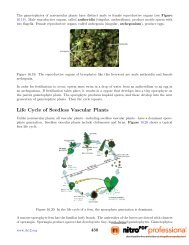Chapter 23 The Circulatory, Respiratory, Digestive, and Excretory ...
Chapter 23 The Circulatory, Respiratory, Digestive, and Excretory ...
Chapter 23 The Circulatory, Respiratory, Digestive, and Excretory ...
Create successful ePaper yourself
Turn your PDF publications into a flip-book with our unique Google optimized e-Paper software.
Figure <strong>23</strong>.38: <strong>The</strong> parts of a nephron <strong>and</strong> their functions are shown in this diagram.<br />
body. Urine leaves the body through another sphincter in the process of urination. This sphincter <strong>and</strong><br />
the process of urination are normally under conscious control.<br />
Kidneys <strong>and</strong> Homeostasis<br />
<strong>The</strong> kidneys play many vital roles in homeostasis. <strong>The</strong>y filter all the blood in the body many times each<br />
day <strong>and</strong> produce a total of about 1.5 liters of urine. <strong>The</strong> kidneys control the amount of water, ions, <strong>and</strong><br />
other substances in the blood by excreting more or less of them in urine. <strong>The</strong> kidneys also secrete hormones<br />
that help maintain homeostasis. Erythropoietin, for example, is a kidney hormone that stimulates bone<br />
marrow to produce red blood cells when more are needed.<br />
<strong>The</strong> kidneys themselves are also regulated by hormones. For example, antidiuretic hormone from the<br />
hypothalamus stimulates the kidneys to produce more concentrated urine when the body is low on water.<br />
Homeostasis <strong>and</strong> feedback mechanisms are discussed in the following two videos: http://www.youtube.<br />
com/watch?v=FTkwJuazIwA&p=5D2D4<strong>23</strong>94C49020A&playnext=1&index=3 (8:24) <strong>and</strong> http:<br />
//www.youtube.com/watch?v=kIVix1O6qEI&p=5D2D4<strong>23</strong>94C49020A&index=5 (8:40).<br />
Kidney Disease <strong>and</strong> Dialysis<br />
A person can live a normal, healthy life with just one kidney. However, at least one kidney must function<br />
properly to maintain life. Diseases that threaten the health <strong>and</strong> functioning of the kidneys include kidney<br />
stones, infections, <strong>and</strong> diabetes.<br />
• Kidney stones are mineral crystals that form in urine inside the kidney. <strong>The</strong>y may be extremely<br />
painful. If they block a ureter, they must be removed so urine can leave the kidney <strong>and</strong> be excreted.<br />
• Bacterial infections of the urinary tract, especially the bladder, are very common. Bladder infections<br />
can be treated with antibiotics prescribed by a doctor. If untreated, they may lead to kidney damage.<br />
• Uncontrolled diabetes may damage capillaries of nephrons. As a result, the kidneys lose much of their<br />
ability to filter blood. This is called kidney failure. <strong>The</strong> only cure for kidney failure is a kidney<br />
www.ck12.org 724





